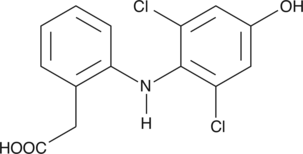Chemicals
Showing 5851–6000 of 41137 results
-
4-hydroxy Diethyltryptamine (4-hydroxy DET) is a substituted tryptamine which is structurally related to the natural hallucinogen psilocin (4-hydroxy dimethyltryptamine). 4-hydroxy DET is a designer drug of abuse.{22648} The physiological and toxicological properties of this compound are poorly studied. This product is intended for forensic and research purposes.
Brand:CaymanSKU:-4-hydroxy Diclofenac is a CYP2C9 metabolite of the NSAID diclofenac (Item No. 70680).{14144,14145,14146} By inhibiting COX and subsequently suppressing PGE2 synthesis, it demonstrates anti-inflammatory and analgesic properties.{28498}
Brand:CaymanSKU:10008518 - 1 mgAvailable on backorder
4-hydroxy Diclofenac is a CYP2C9 metabolite of the NSAID diclofenac (Item No. 70680).{14144,14145,14146} By inhibiting COX and subsequently suppressing PGE2 synthesis, it demonstrates anti-inflammatory and analgesic properties.{28498}
Brand:CaymanSKU:10008518 - 10 mgAvailable on backorder
4-hydroxy Diclofenac is a CYP2C9 metabolite of the NSAID diclofenac (Item No. 70680).{14144,14145,14146} By inhibiting COX and subsequently suppressing PGE2 synthesis, it demonstrates anti-inflammatory and analgesic properties.{28498}
Brand:CaymanSKU:10008518 - 5 mgAvailable on backorder
4-hydroxy DiPT is a short acting, synthetic tryptamine derivative with close structural similarity to the hallucinogen, psilocin, a natural compound found in Psilocybe, Panaeolus, and other psychoactive mushrooms.{20964} This product is intended for forensic and research applications.
Brand:CaymanSKU:11312 - 10 mgAvailable on backorder
4-hydroxy DiPT is a short acting, synthetic tryptamine derivative with close structural similarity to the hallucinogen, psilocin, a natural compound found in Psilocybe, Panaeolus, and other psychoactive mushrooms.{20964} This product is intended for forensic and research applications.
Brand:CaymanSKU:11312 - 25 mgAvailable on backorder
4-hydroxy DiPT is a short acting, synthetic tryptamine derivative with close structural similarity to the hallucinogen, psilocin, a natural compound found in Psilocybe, Panaeolus, and other psychoactive mushrooms.{20964} This product is intended for forensic and research applications.
Brand:CaymanSKU:11312 - 5 mgAvailable on backorder
4-hydroxy DMT (exempt preparation) (Item No. 15696) is an analytical reference standard categorized as a tryptamine.{25254} It is an active metabolite of psilocybin (Item Nos. 14041 | 15695).{25256} 4-hydroxy DMT is regulated as a Schedule I compound in the United States. 4-hydroxy DMT (exempt preparation) (Item No. 15696) is provided as a DEA exempt preparation. This product is intended for research and forensic applications.
Brand:CaymanSKU:-4-hydroxy DPT (Item No. 23542) is an analytical reference standard categorized as a tryptamine. This product is intended for research and forensic applications.
Brand:CaymanSKU:23542 - 1 mgAvailable on backorder
4-hydroxy Hexenal is a lipid peroxidation product derived from oxidized ω-3 fatty acids such as DHA.{1368,2028}
Brand:CaymanSKU:32060 - 1 mgAvailable on backorder
4-hydroxy Hexenal is a lipid peroxidation product derived from oxidized ω-3 fatty acids such as DHA.{1368,2028}
Brand:CaymanSKU:32060 - 10 mgAvailable on backorder
4-hydroxy Hexenal is a lipid peroxidation product derived from oxidized ω-3 fatty acids such as DHA.{1368,2028}
Brand:CaymanSKU:32060 - 25 mgAvailable on backorder
4-hydroxy Hexenal is a lipid peroxidation product derived from oxidized ω-3 fatty acids such as DHA.{1368,2028}
Brand:CaymanSKU:32060 - 5 mgAvailable on backorder
4-hydroxy Hexenal-d3 contains three deuterium atoms at the 6, 6, and 6 positions. It is intended for use as an internal standard for the quantification of 4-hydroxy hexenal (Item No. 32060) by GC- or LC-mass spectrometry. 4-hydroxy Hexenal is a lipid peroxidation product derived from oxidized ω-3 fatty acids such as DHA.{1368,2028}
Brand:CaymanSKU:10007657 - 1 mgAvailable on backorder
4-hydroxy Hexenal-d3 contains three deuterium atoms at the 6, 6, and 6 positions. It is intended for use as an internal standard for the quantification of 4-hydroxy hexenal (Item No. 32060) by GC- or LC-mass spectrometry. 4-hydroxy Hexenal is a lipid peroxidation product derived from oxidized ω-3 fatty acids such as DHA.{1368,2028}
Brand:CaymanSKU:10007657 - 100 µgAvailable on backorder
4-hydroxy Hexenal-d3 contains three deuterium atoms at the 6, 6, and 6 positions. It is intended for use as an internal standard for the quantification of 4-hydroxy hexenal (Item No. 32060) by GC- or LC-mass spectrometry. 4-hydroxy Hexenal is a lipid peroxidation product derived from oxidized ω-3 fatty acids such as DHA.{1368,2028}
Brand:CaymanSKU:10007657 - 50 µgAvailable on backorder
4-hydroxy Hexenal-d3 contains three deuterium atoms at the 6, 6, and 6 positions. It is intended for use as an internal standard for the quantification of 4-hydroxy hexenal (Item No. 32060) by GC- or LC-mass spectrometry. 4-hydroxy Hexenal is a lipid peroxidation product derived from oxidized ω-3 fatty acids such as DHA.{1368,2028}
Brand:CaymanSKU:10007657 - 500 µgAvailable on backorder
4-hydroxy MET is a psychoactive synthetic tryptamine with structural and functional similarities to psilocin, a natural compound found in Psilocybe, Panaeolus, and other psychoactive mushrooms.{20964} This product is intended for forensic and research applications.
Brand:CaymanSKU:11148 - 10 mgAvailable on backorder
4-hydroxy MET is a psychoactive synthetic tryptamine with structural and functional similarities to psilocin, a natural compound found in Psilocybe, Panaeolus, and other psychoactive mushrooms.{20964} This product is intended for forensic and research applications.
Brand:CaymanSKU:11148 - 25 mgAvailable on backorder
4-hydroxy MET is a psychoactive synthetic tryptamine with structural and functional similarities to psilocin, a natural compound found in Psilocybe, Panaeolus, and other psychoactive mushrooms.{20964} This product is intended for forensic and research applications.
Brand:CaymanSKU:11148 - 5 mgAvailable on backorder
4-hydroxy MiPT is a synthetic tryptamine derivative that is part of the class of drugs known as serotonergic psychedelics, which includes psychoactive mushrooms, LSD, and mescaline. Its effects and molecular structure resemble that of the tryptamine psilocin.{20964,21015} This product is intended for forensic and research applications.
Brand:CaymanSKU:11552 - 10 mgAvailable on backorder
4-hydroxy MiPT is a synthetic tryptamine derivative that is part of the class of drugs known as serotonergic psychedelics, which includes psychoactive mushrooms, LSD, and mescaline. Its effects and molecular structure resemble that of the tryptamine psilocin.{20964,21015} This product is intended for forensic and research applications.
Brand:CaymanSKU:11552 - 25 mgAvailable on backorder
4-hydroxy MiPT is a synthetic tryptamine derivative that is part of the class of drugs known as serotonergic psychedelics, which includes psychoactive mushrooms, LSD, and mescaline. Its effects and molecular structure resemble that of the tryptamine psilocin.{20964,21015} This product is intended for forensic and research applications.
Brand:CaymanSKU:11552 - 5 mgAvailable on backorder
4-hydroxy MPT (Item No. 26493) is an analytical reference standard categorized as a tryptamine and a hallucinogen.{45177} This product is intended for research and forensic applications.
Brand:CaymanSKU:26493 - 1 mgAvailable on backorder
4-hydroxy MPT (Item No. 26493) is an analytical reference standard categorized as a tryptamine and a hallucinogen.{45177} This product is intended for research and forensic applications.
Brand:CaymanSKU:26493 - 5 mgAvailable on backorder
4-hydroxy Nonenal is a lipid peroxidation product derived from oxidized ω-6 polyunsaturated fatty acids such as arachidonic acid.{869,1103} 4-hydroxy Nonenal is widely used as a marker of lipid peroxidation.{1103} It exhibits various biological activities such as cytotoxicity, growth inhibiting activity, genotoxicity, and chemotactic activity.{869,1103,1109} 4-hydroxy Nonenal inhibits pro-oxidant-induced Ca2+ release from mitochondria at 10-50 µM.{1103}
Brand:CaymanSKU:32100 - 1 mgAvailable on backorder
4-hydroxy Nonenal is a lipid peroxidation product derived from oxidized ω-6 polyunsaturated fatty acids such as arachidonic acid.{869,1103} 4-hydroxy Nonenal is widely used as a marker of lipid peroxidation.{1103} It exhibits various biological activities such as cytotoxicity, growth inhibiting activity, genotoxicity, and chemotactic activity.{869,1103,1109} 4-hydroxy Nonenal inhibits pro-oxidant-induced Ca2+ release from mitochondria at 10-50 µM.{1103}
Brand:CaymanSKU:32100 - 10 mgAvailable on backorder
4-hydroxy Nonenal is a lipid peroxidation product derived from oxidized ω-6 polyunsaturated fatty acids such as arachidonic acid.{869,1103} 4-hydroxy Nonenal is widely used as a marker of lipid peroxidation.{1103} It exhibits various biological activities such as cytotoxicity, growth inhibiting activity, genotoxicity, and chemotactic activity.{869,1103,1109} 4-hydroxy Nonenal inhibits pro-oxidant-induced Ca2+ release from mitochondria at 10-50 µM.{1103}
Brand:CaymanSKU:32100 - 5 mgAvailable on backorder
4-hydroxy Nonenal is a lipid peroxidation product derived from oxidized ω-6 polyunsaturated fatty acids such as arachidonic acid.{869,1103} 4-hydroxy Nonenal is widely used as a marker of lipid peroxidation.{1103} It exhibits various biological activities such as cytotoxicity, growth inhibiting activity, genotoxicity, and chemotactic activity.{869,1103,1109} 4-hydroxy Nonenal inhibits pro-oxidant-induced Ca2+ release from mitochondria at 10-50 µM.{1103}
Brand:CaymanSKU:32100 - 50 mgAvailable on backorder
4-hydroxy Nonenal (4-HNE) is a major aldehyde produced during the lipid peroxidation of ω-6 polyunsaturated fatty acids, such as arachidonic acid and linoleic acid.{869,1103} It is considered a potential causal agent in numerous diseases, including chronic inflammation, neurodegenerative diseases, atherosclerosis, diabetes, and cancer, in part because it covalently modifies DNA and proteins resulting in genetic mutations and altered cell signaling, respectively.{18126} 4-HNE Alkyne is a form of 4-HNE with a terminal alkyne. Such terminal alkyne groups can be used in linking reactions, known as click chemistry, characterized by high dependability and specificity of azide-alkyne bioconjugation reactions.{17991,17992} Click chemistry has only recently been applied to the study of oxidized lipids.{16188}
Brand:CaymanSKU:-4-hydroxy Nonenal (4-HNE) is a major aldehyde produced during the lipid peroxidation of ω-6 polyunsaturated fatty acids, such as arachidonic acid and linoleic acid.{869,1103} It is considered a potential causal agent in numerous diseases, including chronic inflammation, neurodegenerative diseases, atherosclerosis, diabetes, and cancer, in part because it covalently modifies DNA and proteins resulting in genetic mutations and altered cell signaling, respectively.{18126} 4-HNE Alkyne is a form of 4-HNE with a terminal alkyne. Such terminal alkyne groups can be used in linking reactions, known as click chemistry, characterized by high dependability and specificity of azide-alkyne bioconjugation reactions.{17991,17992} Click chemistry has only recently been applied to the study of oxidized lipids.{16188}
Brand:CaymanSKU:-4-hydroxy Nonenal (4-HNE) is a major aldehyde produced during the lipid peroxidation of ω-6 polyunsaturated fatty acids, such as arachidonic acid and linoleic acid.{869,1103} It is considered a potential causal agent in numerous diseases, including chronic inflammation, neurodegenerative diseases, atherosclerosis, diabetes, and cancer, in part because it covalently modifies DNA and proteins resulting in genetic mutations and altered cell signaling, respectively.{18126} 4-HNE Alkyne is a form of 4-HNE with a terminal alkyne. Such terminal alkyne groups can be used in linking reactions, known as click chemistry, characterized by high dependability and specificity of azide-alkyne bioconjugation reactions.{17991,17992} Click chemistry has only recently been applied to the study of oxidized lipids.{16188}
Brand:CaymanSKU:-4-hydroxy Nonenal (4-HNE) is a major aldehyde produced during the lipid peroxidation of ω-6 polyunsaturated fatty acids, such as arachidonic acid and linoleic acid.{869,1103} It is considered a potential causal agent in numerous diseases, including chronic inflammation, neurodegenerative diseases, atherosclerosis, diabetes, and cancer, in part because it covalently modifies DNA and proteins resulting in genetic mutations and altered cell signaling, respectively.{18126} 4-HNE Alkyne is a form of 4-HNE with a terminal alkyne. Such terminal alkyne groups can be used in linking reactions, known as click chemistry, characterized by high dependability and specificity of azide-alkyne bioconjugation reactions.{17991,17992} Click chemistry has only recently been applied to the study of oxidized lipids.{16188}
Brand:CaymanSKU:-Peroxidation of common ω-6 polyunsaturated fatty acids (PUFAs) such as linoleic acid, DGLA, and arachidonic acid can give rise to 4-HNE. 4-HNE is cleared rapidly from the plasma and undergoes enterohepatic circulation as a glutathione conjugate in the rat.{7334} About two thirds of an administered dose of 4-HNE is excreted within 48 hours in the urine, primarily in the form of mercapturic acid conjugates.{8626} The C-1 aldehyde of 4-HNE is reduced to an alcohol in about half of these metabolites. The remainder are C-1 aldehydes or have been oxidized to C-1 carboxylic acids. These aldehydes and carboxylic acids can also form γ-lactols and γ-lactones, respectively, producing at least 4 or 5 end urinary metabolites of 4-HNE in vivo.
Brand:CaymanSKU:32110 - 1 mgAvailable on backorder
Peroxidation of common ω-6 polyunsaturated fatty acids (PUFAs) such as linoleic acid, DGLA, and arachidonic acid can give rise to 4-HNE. 4-HNE is cleared rapidly from the plasma and undergoes enterohepatic circulation as a glutathione conjugate in the rat.{7334} About two thirds of an administered dose of 4-HNE is excreted within 48 hours in the urine, primarily in the form of mercapturic acid conjugates.{8626} The C-1 aldehyde of 4-HNE is reduced to an alcohol in about half of these metabolites. The remainder are C-1 aldehydes or have been oxidized to C-1 carboxylic acids. These aldehydes and carboxylic acids can also form γ-lactols and γ-lactones, respectively, producing at least 4 or 5 end urinary metabolites of 4-HNE in vivo.
Brand:CaymanSKU:32110 - 10 mgAvailable on backorder
Peroxidation of common ω-6 polyunsaturated fatty acids (PUFAs) such as linoleic acid, DGLA, and arachidonic acid can give rise to 4-HNE. 4-HNE is cleared rapidly from the plasma and undergoes enterohepatic circulation as a glutathione conjugate in the rat.{7334} About two thirds of an administered dose of 4-HNE is excreted within 48 hours in the urine, primarily in the form of mercapturic acid conjugates.{8626} The C-1 aldehyde of 4-HNE is reduced to an alcohol in about half of these metabolites. The remainder are C-1 aldehydes or have been oxidized to C-1 carboxylic acids. These aldehydes and carboxylic acids can also form γ-lactols and γ-lactones, respectively, producing at least 4 or 5 end urinary metabolites of 4-HNE in vivo.
Brand:CaymanSKU:32110 - 5 mgAvailable on backorder
4-hydroxy Nonenal-d3 (4-HNF-d3) contains three deuterium atoms at the terminal methyl position. It is intended for use as an internal standard for the quantification of 4-HNE by GC- or LC-mass spectrometry. 4-HNE is a lipid peroxidation product derived from oxidized ω-6 polyunsaturated fatty acids such as arachidonic acid.{869,1103} 4-HNE is widely used as a marker of lipid peroxidation.{1103} It exhibits various biological activities such as cytotoxicity, growth inhibiting activity, genotoxicity, and chemotactic activity.{869,1103,1109} 4-HNE inhibits pro-oxidant-induced Ca2+ release from mitochondria at 10-50 µM.{1103}
Brand:CaymanSKU:332101 - 1 mgAvailable on backorder
4-hydroxy Nonenal-d3 (4-HNF-d3) contains three deuterium atoms at the terminal methyl position. It is intended for use as an internal standard for the quantification of 4-HNE by GC- or LC-mass spectrometry. 4-HNE is a lipid peroxidation product derived from oxidized ω-6 polyunsaturated fatty acids such as arachidonic acid.{869,1103} 4-HNE is widely used as a marker of lipid peroxidation.{1103} It exhibits various biological activities such as cytotoxicity, growth inhibiting activity, genotoxicity, and chemotactic activity.{869,1103,1109} 4-HNE inhibits pro-oxidant-induced Ca2+ release from mitochondria at 10-50 µM.{1103}
Brand:CaymanSKU:332101 - 100 µgAvailable on backorder
4-hydroxy Nonenal-d3 (4-HNF-d3) contains three deuterium atoms at the terminal methyl position. It is intended for use as an internal standard for the quantification of 4-HNE by GC- or LC-mass spectrometry. 4-HNE is a lipid peroxidation product derived from oxidized ω-6 polyunsaturated fatty acids such as arachidonic acid.{869,1103} 4-HNE is widely used as a marker of lipid peroxidation.{1103} It exhibits various biological activities such as cytotoxicity, growth inhibiting activity, genotoxicity, and chemotactic activity.{869,1103,1109} 4-HNE inhibits pro-oxidant-induced Ca2+ release from mitochondria at 10-50 µM.{1103}
Brand:CaymanSKU:332101 - 50 µgAvailable on backorder
4-hydroxy Nonenal-d3 (4-HNF-d3) contains three deuterium atoms at the terminal methyl position. It is intended for use as an internal standard for the quantification of 4-HNE by GC- or LC-mass spectrometry. 4-HNE is a lipid peroxidation product derived from oxidized ω-6 polyunsaturated fatty acids such as arachidonic acid.{869,1103} 4-HNE is widely used as a marker of lipid peroxidation.{1103} It exhibits various biological activities such as cytotoxicity, growth inhibiting activity, genotoxicity, and chemotactic activity.{869,1103,1109} 4-HNE inhibits pro-oxidant-induced Ca2+ release from mitochondria at 10-50 µM.{1103}
Brand:CaymanSKU:332101 - 500 µgAvailable on backorder
4-hydroxy Tolbutamide is a cytochrome P450 2C8 (CYP2C8) and CYP2C9 metabolite of tolbutamide, a first-generation potassium channel blocker.{14142} Tolbutamide 4-hydroxylation is an often used probe reaction in the pharmaceutical industry for the characterization of CYP2C8 and CYP2C9 involvement in the metabolism of clinical drugs.{32474,14143,14141}
Brand:CaymanSKU:10008520 - 1 mgAvailable on backorder
4-hydroxy Tolbutamide is a cytochrome P450 2C8 (CYP2C8) and CYP2C9 metabolite of tolbutamide, a first-generation potassium channel blocker.{14142} Tolbutamide 4-hydroxylation is an often used probe reaction in the pharmaceutical industry for the characterization of CYP2C8 and CYP2C9 involvement in the metabolism of clinical drugs.{32474,14143,14141}
Brand:CaymanSKU:10008520 - 10 mgAvailable on backorder
4-hydroxy Tolbutamide is a cytochrome P450 2C8 (CYP2C8) and CYP2C9 metabolite of tolbutamide, a first-generation potassium channel blocker.{14142} Tolbutamide 4-hydroxylation is an often used probe reaction in the pharmaceutical industry for the characterization of CYP2C8 and CYP2C9 involvement in the metabolism of clinical drugs.{32474,14143,14141}
Brand:CaymanSKU:10008520 - 25 mgAvailable on backorder
4-hydroxy Tolbutamide is a cytochrome P450 2C8 (CYP2C8) and CYP2C9 metabolite of tolbutamide, a first-generation potassium channel blocker.{14142} Tolbutamide 4-hydroxylation is an often used probe reaction in the pharmaceutical industry for the characterization of CYP2C8 and CYP2C9 involvement in the metabolism of clinical drugs.{32474,14143,14141}
Brand:CaymanSKU:10008520 - 5 mgAvailable on backorder
4-hydroxy Valsartan is a major metabolite of the angiotensin II type 1 (AT1) receptor antagonist valsartan (Item No. 14178).{43882} It reduces platelet aggregation induced by epinephrine (Item No. 21245) and collagen but not ADP in human whole blood.
Brand:CaymanSKU:27849 - 2.5 mgAvailable on backorder
4-hydroxy Xylazine is a metabolite of xylazine (Item Nos. 14113 | 22641).{40093} Xylazine is an agonist of α2-adrenergic receptors used for sedation, anesthesia, and analgesia in non-human mammals.{25422,29404,29405} 4-hydroxy Xylazine has been used as a marker for xylazine doping in MS analysis of equine urine.{40093}
Brand:CaymanSKU:22920 - 1 mgAvailable on backorder
4-hydroxy Xylazine is a metabolite of xylazine (Item Nos. 14113 | 22641).{40093} Xylazine is an agonist of α2-adrenergic receptors used for sedation, anesthesia, and analgesia in non-human mammals.{25422,29404,29405} 4-hydroxy Xylazine has been used as a marker for xylazine doping in MS analysis of equine urine.{40093}
Brand:CaymanSKU:22920 - 5 mgAvailable on backorder
4-hydroxy Xylazine is a metabolite of xylazine (Item Nos. 14113 | 22641).{40093} Xylazine is an agonist of α2-adrenergic receptors used for sedation, anesthesia, and analgesia in non-human mammals.{25422,29404,29405} 4-hydroxy Xylazine has been used as a marker for xylazine doping in MS analysis of equine urine.{40093}
Brand:CaymanSKU:22920 - 500 µgAvailable on backorder
3,4-MDMA, also known as ecstasy, is a euphoric entactogen which is illegal in most countries and is regulated (Schedule I) in the United States.{21236} HMA, known more formally as 4-hydroxy-3-methoxyamphetamine, is a metabolite of 3,4-MDMA.{23484,23483} It is typically glucuronidated or sulfated before excretion and detected in urine after cleavage, although intact forms may also be measured.{23484,23483} This product is intended for forensic and research purposes.
Brand:CaymanSKU:-3,4-MDMA, also known as ecstasy, is a euphoric entactogen which is illegal in most countries and is regulated (Schedule I) in the United States.{21236} HMA, known more formally as 4-hydroxy-3-methoxyamphetamine, is a metabolite of 3,4-MDMA.{23484,23483} It is typically glucuronidated or sulfated before excretion and detected in urine after cleavage, although intact forms may also be measured.{23484,23483} This product is intended for forensic and research purposes.
Brand:CaymanSKU:-4-hydroxy-3-Methoxyphenylglycol (piperazine salt) is a metabolite of norepinephrine derived in part by deamination of normetanephrine or by O-methylation of dihydroxyphenylglycol after cellular uptake of either intermediate.{25427} It is released into the blood and cerebrospinal fluid and has been used as a biochemical index of recent sympathetic nervous system activity.{32483}
Brand:CaymanSKU:19714 -Available on backorder
4-hydroxy-3-Methoxyphenylglycol (piperazine salt) is a metabolite of norepinephrine derived in part by deamination of normetanephrine or by O-methylation of dihydroxyphenylglycol after cellular uptake of either intermediate.{25427} It is released into the blood and cerebrospinal fluid and has been used as a biochemical index of recent sympathetic nervous system activity.{32483}
Brand:CaymanSKU:19714 -Available on backorder
4-hydroxy-3-Methoxyphenylglycol (piperazine salt) is a metabolite of norepinephrine derived in part by deamination of normetanephrine or by O-methylation of dihydroxyphenylglycol after cellular uptake of either intermediate.{25427} It is released into the blood and cerebrospinal fluid and has been used as a biochemical index of recent sympathetic nervous system activity.{32483}
Brand:CaymanSKU:19714 -Available on backorder
4-Hydroxy-6-methyl-2-pyrone is a fungal metabolite that has been isolated from H. investians.{36677}
Brand:CaymanSKU:25210 - 25 mgAvailable on backorder
4-Hydroxy-6-methyl-2-pyrone is a fungal metabolite that has been isolated from H. investians.{36677}
Brand:CaymanSKU:25210 - 5 mgAvailable on backorder
4-Hydroxybenzoic acid is a phenolic acid that has been found in a variety of fruit peels and leaves.{48367,48368}
Brand:CaymanSKU:27468 - 250 gAvailable on backorder
4-Hydroxybenzyl alcohol is a phenol and an aglycone form of gastrodin (Item No. 28828) that has been found in Gastrodia and has diverse biological activities.{52695,52696,52698,52697} It inhibits LPS-induced production of nitric oxide (NO) and reactive oxygen species (ROS) and decreases inducible nitric oxide synthase (iNOS), but not COX-2, levels in RAW 264.7 cells when used at concentrations of 0.5 and 1 mM.{52696} 4-Hydroxybenzyl alcohol (1.5 and 4.5 mg/animal) reduces exudate volume and leukocyte infiltration in a rat model of carrageenan-induced air pouch inflammation, and inhibits acetic acid-induced writhing in mice when administered at doses of 50 and 100 mg/kg. It reduces infarct volume and the number of TUNEL-positive neurons in the ipsilateral cortex in a rat model of focal cerebral ischemia induced by transient middle cerebral artery occlusion (MCAO) when administered at a dose of 50 mg/kg.{52698} 4-Hydroxybenzyl alcohol (50 and 100 mg/kg) increases the number of entries into, and the percentage of time spent in, the open arms of the elevated plus maze in mice, indicating anxiolytic-like activity.{52697}
Brand:CaymanSKU:31209 - 10 gAvailable on backorder
4-Hydroxybenzyl alcohol is a phenol and an aglycone form of gastrodin (Item No. 28828) that has been found in Gastrodia and has diverse biological activities.{52695,52696,52698,52697} It inhibits LPS-induced production of nitric oxide (NO) and reactive oxygen species (ROS) and decreases inducible nitric oxide synthase (iNOS), but not COX-2, levels in RAW 264.7 cells when used at concentrations of 0.5 and 1 mM.{52696} 4-Hydroxybenzyl alcohol (1.5 and 4.5 mg/animal) reduces exudate volume and leukocyte infiltration in a rat model of carrageenan-induced air pouch inflammation, and inhibits acetic acid-induced writhing in mice when administered at doses of 50 and 100 mg/kg. It reduces infarct volume and the number of TUNEL-positive neurons in the ipsilateral cortex in a rat model of focal cerebral ischemia induced by transient middle cerebral artery occlusion (MCAO) when administered at a dose of 50 mg/kg.{52698} 4-Hydroxybenzyl alcohol (50 and 100 mg/kg) increases the number of entries into, and the percentage of time spent in, the open arms of the elevated plus maze in mice, indicating anxiolytic-like activity.{52697}
Brand:CaymanSKU:31209 - 100 gAvailable on backorder
4-Hydroxybenzyl alcohol is a phenol and an aglycone form of gastrodin (Item No. 28828) that has been found in Gastrodia and has diverse biological activities.{52695,52696,52698,52697} It inhibits LPS-induced production of nitric oxide (NO) and reactive oxygen species (ROS) and decreases inducible nitric oxide synthase (iNOS), but not COX-2, levels in RAW 264.7 cells when used at concentrations of 0.5 and 1 mM.{52696} 4-Hydroxybenzyl alcohol (1.5 and 4.5 mg/animal) reduces exudate volume and leukocyte infiltration in a rat model of carrageenan-induced air pouch inflammation, and inhibits acetic acid-induced writhing in mice when administered at doses of 50 and 100 mg/kg. It reduces infarct volume and the number of TUNEL-positive neurons in the ipsilateral cortex in a rat model of focal cerebral ischemia induced by transient middle cerebral artery occlusion (MCAO) when administered at a dose of 50 mg/kg.{52698} 4-Hydroxybenzyl alcohol (50 and 100 mg/kg) increases the number of entries into, and the percentage of time spent in, the open arms of the elevated plus maze in mice, indicating anxiolytic-like activity.{52697}
Brand:CaymanSKU:31209 - 250 gAvailable on backorder
4-Hydroxybenzyl alcohol is a phenol and an aglycone form of gastrodin (Item No. 28828) that has been found in Gastrodia and has diverse biological activities.{52695,52696,52698,52697} It inhibits LPS-induced production of nitric oxide (NO) and reactive oxygen species (ROS) and decreases inducible nitric oxide synthase (iNOS), but not COX-2, levels in RAW 264.7 cells when used at concentrations of 0.5 and 1 mM.{52696} 4-Hydroxybenzyl alcohol (1.5 and 4.5 mg/animal) reduces exudate volume and leukocyte infiltration in a rat model of carrageenan-induced air pouch inflammation, and inhibits acetic acid-induced writhing in mice when administered at doses of 50 and 100 mg/kg. It reduces infarct volume and the number of TUNEL-positive neurons in the ipsilateral cortex in a rat model of focal cerebral ischemia induced by transient middle cerebral artery occlusion (MCAO) when administered at a dose of 50 mg/kg.{52698} 4-Hydroxybenzyl alcohol (50 and 100 mg/kg) increases the number of entries into, and the percentage of time spent in, the open arms of the elevated plus maze in mice, indicating anxiolytic-like activity.{52697}
Brand:CaymanSKU:31209 - 50 gAvailable on backorder
4-Hydroxybenzyl isothiocyanate (HBITC) is a hydrogen sulfide (H2S) originally isolated from S. alba seeds.{48388} It releases H2S in the presence and absence of L-cysteine in a concentration-dependent manner. HBITC (60-80 μM) increases levels of thiosulfate, decreases the mitochondrial membrane potential, and inhibits proliferation of SH-SY5Y human neuroblastoma and U87MG glioblastoma cells.{48389}
Brand:CaymanSKU:-Available on backorder
4-Hydroxybenzyl isothiocyanate (HBITC) is a hydrogen sulfide (H2S) originally isolated from S. alba seeds.{48388} It releases H2S in the presence and absence of L-cysteine in a concentration-dependent manner. HBITC (60-80 μM) increases levels of thiosulfate, decreases the mitochondrial membrane potential, and inhibits proliferation of SH-SY5Y human neuroblastoma and U87MG glioblastoma cells.{48389}
Brand:CaymanSKU:-Available on backorder
4-Hydroxyestradiol is a catechol estrogen and minor metabolite of estrogen.{57239,57240} 4-Hydroxyestradiol is formed from estrogen by the cytochrome P450 (CYP) isoform CYP1B1.{57240} Production of 4-hydroxyestradiol is increased in microsomes prepared from human mammary adenocarcinoma and fibroadenoma microsomes compared with microsomes prepared from non-cancerous tissues.{57239} 4-Hydroxyestradiol (25 mg/animal) induces renal tumor formation in male hamsters.{57241}
Brand:CaymanSKU:31508 - 1 mgAvailable on backorder
4-Hydroxyestradiol is a catechol estrogen and minor metabolite of estrogen.{57239,57240} 4-Hydroxyestradiol is formed from estrogen by the cytochrome P450 (CYP) isoform CYP1B1.{57240} Production of 4-hydroxyestradiol is increased in microsomes prepared from human mammary adenocarcinoma and fibroadenoma microsomes compared with microsomes prepared from non-cancerous tissues.{57239} 4-Hydroxyestradiol (25 mg/animal) induces renal tumor formation in male hamsters.{57241}
Brand:CaymanSKU:31508 - 10 mgAvailable on backorder
4-Hydroxyestradiol is a catechol estrogen and minor metabolite of estrogen.{57239,57240} 4-Hydroxyestradiol is formed from estrogen by the cytochrome P450 (CYP) isoform CYP1B1.{57240} Production of 4-hydroxyestradiol is increased in microsomes prepared from human mammary adenocarcinoma and fibroadenoma microsomes compared with microsomes prepared from non-cancerous tissues.{57239} 4-Hydroxyestradiol (25 mg/animal) induces renal tumor formation in male hamsters.{57241}
Brand:CaymanSKU:31508 - 5 mgAvailable on backorder
4-Hydroxyestradiol is a catechol estrogen and minor metabolite of estrogen.{57239,57240} 4-Hydroxyestradiol is formed from estrogen by the cytochrome P450 (CYP) isoform CYP1B1.{57240} Production of 4-hydroxyestradiol is increased in microsomes prepared from human mammary adenocarcinoma and fibroadenoma microsomes compared with microsomes prepared from non-cancerous tissues.{57239} 4-Hydroxyestradiol (25 mg/animal) induces renal tumor formation in male hamsters.{57241}
Brand:CaymanSKU:31508 - 500 µgAvailable on backorder
4-Hydroxyisoleucine is an amino acid that has been found in fenugreek (T. foenum graecum) seeds and has antidiabetic activity.{51117,51118,51119} It increases glucose-stimulated insulin release from isolated rat islets and isolated perfused rat pancreas when used at a concentration of 200 μM.{51117} In vivo, 4-hydroxyisoleucine increases PI3K activity in muscle and liver in rats when administered at a dose of 18 mg/kg and in muscle in a rat model of type 2 diabetes induced by nicotinamide (Item No. 11127) and streptozotocin (STZ; Item No. 13104) when administered at 25 mg/kg.{51118} 4-Hydroxyisoleucine (50 mg/kg per day for four weeks) decreases plasma glucose, triglyceride, LDL, HDL, and cholesterol levels in an STZ-induced rat model of type 1 diabetes.{51119}
Brand:CaymanSKU:11812 - 1 mgAvailable on backorder
4-Hydroxyisoleucine is an amino acid that has been found in fenugreek (T. foenum graecum) seeds and has antidiabetic activity.{51117,51118,51119} It increases glucose-stimulated insulin release from isolated rat islets and isolated perfused rat pancreas when used at a concentration of 200 μM.{51117} In vivo, 4-hydroxyisoleucine increases PI3K activity in muscle and liver in rats when administered at a dose of 18 mg/kg and in muscle in a rat model of type 2 diabetes induced by nicotinamide (Item No. 11127) and streptozotocin (STZ; Item No. 13104) when administered at 25 mg/kg.{51118} 4-Hydroxyisoleucine (50 mg/kg per day for four weeks) decreases plasma glucose, triglyceride, LDL, HDL, and cholesterol levels in an STZ-induced rat model of type 1 diabetes.{51119}
Brand:CaymanSKU:11812 - 10 mgAvailable on backorder
4-Hydroxyisoleucine is an amino acid that has been found in fenugreek (T. foenum graecum) seeds and has antidiabetic activity.{51117,51118,51119} It increases glucose-stimulated insulin release from isolated rat islets and isolated perfused rat pancreas when used at a concentration of 200 μM.{51117} In vivo, 4-hydroxyisoleucine increases PI3K activity in muscle and liver in rats when administered at a dose of 18 mg/kg and in muscle in a rat model of type 2 diabetes induced by nicotinamide (Item No. 11127) and streptozotocin (STZ; Item No. 13104) when administered at 25 mg/kg.{51118} 4-Hydroxyisoleucine (50 mg/kg per day for four weeks) decreases plasma glucose, triglyceride, LDL, HDL, and cholesterol levels in an STZ-induced rat model of type 1 diabetes.{51119}
Brand:CaymanSKU:11812 - 25 mgAvailable on backorder
4-Hydroxyisoleucine is an amino acid that has been found in fenugreek (T. foenum graecum) seeds and has antidiabetic activity.{51117,51118,51119} It increases glucose-stimulated insulin release from isolated rat islets and isolated perfused rat pancreas when used at a concentration of 200 μM.{51117} In vivo, 4-hydroxyisoleucine increases PI3K activity in muscle and liver in rats when administered at a dose of 18 mg/kg and in muscle in a rat model of type 2 diabetes induced by nicotinamide (Item No. 11127) and streptozotocin (STZ; Item No. 13104) when administered at 25 mg/kg.{51118} 4-Hydroxyisoleucine (50 mg/kg per day for four weeks) decreases plasma glucose, triglyceride, LDL, HDL, and cholesterol levels in an STZ-induced rat model of type 1 diabetes.{51119}
Brand:CaymanSKU:11812 - 5 mgAvailable on backorder
4-Hydroxymethamphetamine (hydrochloride) is an analytical reference standard categorized as an amphetamine. It is a metabolite of methamphetamine (Item Nos. 14216 | ISO60168).{47743} This product is intended for research and forensic applications.
Brand:CaymanSKU:9002128 - 1 mgAvailable on backorder
4-Hydroxymethamphetamine (hydrochloride) is an analytical reference standard categorized as an amphetamine. It is a metabolite of methamphetamine (Item Nos. 14216 | ISO60168).{47743} This product is intended for research and forensic applications.
Brand:CaymanSKU:9002128 - 5 mgAvailable on backorder
4-Hydroxyphenylacetic acid is a phenolic acid with anti-inflammatory activity.{46255} It is formed via microbial metabolism of aromatic amino acids and polyphenolic compounds, including flavonoid glycosides, by gut microbiota.{46256,46257,46258} 4-Hydroxyphenylacetic acid (100 mg/kg) inhibits seawater instillation-induced increases in TNF-α, IL-1β, and IL-6 levels in lung tissue and white blood cell numbers in bronchoalveolar lavage fluid (BALF) and prevents lung edema in a rat model of acute lung injury.{46255} Levels of 4-hydroxyphenylacetic acid are increased and decreased in serum and urine, respectively, in rats fed a high-fat diet.{46256} Serum levels of 4-hydroxyphenylacetic acid are increased in patients with stage III pancreatic cancer.{46259}
Brand:CaymanSKU:26613 - 100 gAvailable on backorder
4-Hydroxyphenylacetic acid is a phenolic acid with anti-inflammatory activity.{46255} It is formed via microbial metabolism of aromatic amino acids and polyphenolic compounds, including flavonoid glycosides, by gut microbiota.{46256,46257,46258} 4-Hydroxyphenylacetic acid (100 mg/kg) inhibits seawater instillation-induced increases in TNF-α, IL-1β, and IL-6 levels in lung tissue and white blood cell numbers in bronchoalveolar lavage fluid (BALF) and prevents lung edema in a rat model of acute lung injury.{46255} Levels of 4-hydroxyphenylacetic acid are increased and decreased in serum and urine, respectively, in rats fed a high-fat diet.{46256} Serum levels of 4-hydroxyphenylacetic acid are increased in patients with stage III pancreatic cancer.{46259}
Brand:CaymanSKU:26613 - 25 gAvailable on backorder
4-Hydroxyphenylacetic acid is a phenolic acid with anti-inflammatory activity.{46255} It is formed via microbial metabolism of aromatic amino acids and polyphenolic compounds, including flavonoid glycosides, by gut microbiota.{46256,46257,46258} 4-Hydroxyphenylacetic acid (100 mg/kg) inhibits seawater instillation-induced increases in TNF-α, IL-1β, and IL-6 levels in lung tissue and white blood cell numbers in bronchoalveolar lavage fluid (BALF) and prevents lung edema in a rat model of acute lung injury.{46255} Levels of 4-hydroxyphenylacetic acid are increased and decreased in serum and urine, respectively, in rats fed a high-fat diet.{46256} Serum levels of 4-hydroxyphenylacetic acid are increased in patients with stage III pancreatic cancer.{46259}
Brand:CaymanSKU:26613 - 250 gAvailable on backorder
4-Hydroxyphenylacetic acid is a phenolic acid with anti-inflammatory activity.{46255} It is formed via microbial metabolism of aromatic amino acids and polyphenolic compounds, including flavonoid glycosides, by gut microbiota.{46256,46257,46258} 4-Hydroxyphenylacetic acid (100 mg/kg) inhibits seawater instillation-induced increases in TNF-α, IL-1β, and IL-6 levels in lung tissue and white blood cell numbers in bronchoalveolar lavage fluid (BALF) and prevents lung edema in a rat model of acute lung injury.{46255} Levels of 4-hydroxyphenylacetic acid are increased and decreased in serum and urine, respectively, in rats fed a high-fat diet.{46256} Serum levels of 4-hydroxyphenylacetic acid are increased in patients with stage III pancreatic cancer.{46259}
Brand:CaymanSKU:26613 - 50 gAvailable on backorder
4-IBP is a sigma-1 (σ1) receptor ligand (Ki = 1.7 nM).{61020,61021} It is selective for σ1 over σ2 receptors (Ki = 25.2 nM). It inhibits the growth and migration of PC3 prostate cancer and A549 non-small cell lung cancer (NSCLC) cells, as well as the migration of C32 melanoma and U373 MG glioblastoma cells, when used at a concentration of 10 µM.{61020} 4-IBP (2 mg/kg) increases survival in a U373 MG mouse xenograft model. It also increases firing of serotonergic neurons in the rat dorsal raphe nucleus when administered at a dose of 2 mg/kg.{61021}
Brand:CaymanSKU:31518 - 10 mgAvailable on backorder
4-IBP is a sigma-1 (σ1) receptor ligand (Ki = 1.7 nM).{61020,61021} It is selective for σ1 over σ2 receptors (Ki = 25.2 nM). It inhibits the growth and migration of PC3 prostate cancer and A549 non-small cell lung cancer (NSCLC) cells, as well as the migration of C32 melanoma and U373 MG glioblastoma cells, when used at a concentration of 10 µM.{61020} 4-IBP (2 mg/kg) increases survival in a U373 MG mouse xenograft model. It also increases firing of serotonergic neurons in the rat dorsal raphe nucleus when administered at a dose of 2 mg/kg.{61021}
Brand:CaymanSKU:31518 - 25 mgAvailable on backorder
4-IBP is a sigma-1 (σ1) receptor ligand (Ki = 1.7 nM).{61020,61021} It is selective for σ1 over σ2 receptors (Ki = 25.2 nM). It inhibits the growth and migration of PC3 prostate cancer and A549 non-small cell lung cancer (NSCLC) cells, as well as the migration of C32 melanoma and U373 MG glioblastoma cells, when used at a concentration of 10 µM.{61020} 4-IBP (2 mg/kg) increases survival in a U373 MG mouse xenograft model. It also increases firing of serotonergic neurons in the rat dorsal raphe nucleus when administered at a dose of 2 mg/kg.{61021}
Brand:CaymanSKU:31518 - 5 mgAvailable on backorder
4-IBP is a sigma-1 (σ1) receptor ligand (Ki = 1.7 nM).{61020,61021} It is selective for σ1 over σ2 receptors (Ki = 25.2 nM). It inhibits the growth and migration of PC3 prostate cancer and A549 non-small cell lung cancer (NSCLC) cells, as well as the migration of C32 melanoma and U373 MG glioblastoma cells, when used at a concentration of 10 µM.{61020} 4-IBP (2 mg/kg) increases survival in a U373 MG mouse xenograft model. It also increases firing of serotonergic neurons in the rat dorsal raphe nucleus when administered at a dose of 2 mg/kg.{61021}
Brand:CaymanSKU:31518 - 50 mgAvailable on backorder
4-iodo-SAHA is a hydrophobic derivative of the class I and class II histone deacetylase (HDAC) inhibitor SAHA. At 1 μM it demonstrates >60% inhibition of HDAC1 and HDAC6 activity in a deacetylase activity assay, similar to that of SAHA. 4-iodo-SAHA inhibits proliferation of SK-BR-3 breast-derived and HT29 colon-derived cell lines with EC50 values comparable to that of SAHA (1.1 and 0.95 μM versus 2.1 and 2 μM, respectively). It is 10-fold more potent as an inhibitor of U937 leukemia cell proliferation compared to SAHA (0.12 μM versus 1.2 μM, respectively).{18112}
Brand:CaymanSKU:10495 - 100 mgAvailable on backorder




























